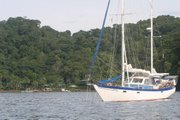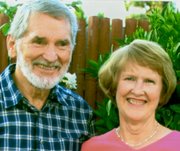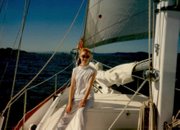The next morning we set the stern hook to hold Carricklee’s bow into the swells breaking around the point. Completing our morning chores below decks, we became aware of whistling alongside us but paid no attention, often the fishermen whistle as they pass close by the boat. But this whistle persisted as did the sound of a nearby engine. One of the tour boats en route to Isla de la Plata had stopped for a crewman to tell us to hail the port captain, who had been hailing us on the VHF radio. Oops! We hadn’t turned our radio on for the morning. The port captain requested we come ashore and present our official documents. Visiting sailors cannot, of course, refuse such a request. We had wanted to go ashore to see the town, but had been reluctant to challenge the breakers on the beach. His request took care of our hesitancy.
To our relief, we made a splendid landing, timing the swells, then, after rowing the boat stern first to the beach, stepping off with no more than wet feet. (I had worn my old rather than new glasses in case we took a dunking.) We walked the mile or so to the other end of the beach, threading our way past the fishermen offloading their night’s catches into space cases, carts, truck beds, and the hands of buyers. The brown pelicans snatched up any leftovers.
The port captain welcomed us most amiably, looked at our passports, stamped our zarpe, wished us “Buen Viaje” as he shook our hands, and sent us on our way.
The dusty streets of Puerto López were a bustle of pedicabs and walkers, with a pervading odor of fish throughout. We found the headquarters of the Parque Nacional de Machalilla, where we purchased tickets to visit Isla de la Plata the following day.
Back aboard Carricklee, we received a VHF call from the sailboat Clair de Lune, passing outside the bay, to inquire about the anchorages between here and Puerto Lucía YC, their destination. In return, they recommended the anchorage behind the “big rock” off the fishing village Machalilla, our next destination.
After lunch, we hoisted anchor and were under way at 1410, arriving there at 1520. The anchorage behind little Islote Sucre was indeed a splendid one. We were across the bay from the noisy fishing harbor; for entertainment we contented ourselves with the cormorants, pelicans, and black-headed vultures scattered on the rocky islet, the only sounds the swells thundering on the opposite side of the islet, exactly where we desired that thunder to remain.
The following morning we tried a batch of hotcakes from the sourdough starter I’d made a couple of weeks earlier. The result was favorable, though the dough was not as good and sour as from our previous starter. We’d been carrying back and forth each cruising season a jar of starter our friend Katie Bloom had brought to us when we were in Hawaii in 1997, the starter at that time about 25 years old. We had nursed it, fed it, and shared it wherever we had been by sea or land since that time. But we knew this year we weren’t going to get it aboard an airplane in our carry-on luggage. So we divided it and left one jar in the care of our granddaughter, Elise, and her husband, Chris, and the other jar in Vickie and Jon’s freezer—this latter an experiment to see if the yeast can survive being frozen. But, since sourdough was born in the far northern reaches of Alaska, we should think the chances are good that it can. We’ll be happy to reunite with our babies next summer.
Fortified for our chores for the day, we were busy on the boat when a fishing panga came alongside, and one of the three young fishermen chatted for awhile before asking if we’d like them to go to the “tierra” and bring back “langostina.” We agreed that would be a fine idea, and they returned an hour or so later with nine of the largest prawns we’ve ever seen. As they motored away, we checked our watches and nodded: not too soon to prepare lunch.
Ours was the quintessential cruising sailors’ lunch—shrimp Louis with local lettuce, sweet tomatoes, crisp cucumbers, and onions, dressed with freshly made Louis a la Carricklee, and served in a quietly gorgeous remote anchorage.
The winds had risen to 20 knots by mid-afternoon, but we still needed to get out in the sport boat and take photographs. We motored slowly to keep ourselves from getting drenched and captured some good images of the sparkling water and environs. All was well until the sport boat was back alongside Carricklee. As I stood on the thwart and grabbed the boarding ladder, a big swell caught the sport boat and it bounced off the hull and out from beneath me. I had but a moment to wonder where I might end up as I was stretched my length between the two boats. But quick-thinking Bob grabbed me with one arm around the waist and pulled me back into the sport boat, where we fell in a heap, but a safe heap. My hero once again! (I’m going to have to watch that waistline to make sure he can always reach around it with one arm.)
Wednesday, November 29, 2006
Subscribe to:
Post Comments (Atom)






No comments:
Post a Comment